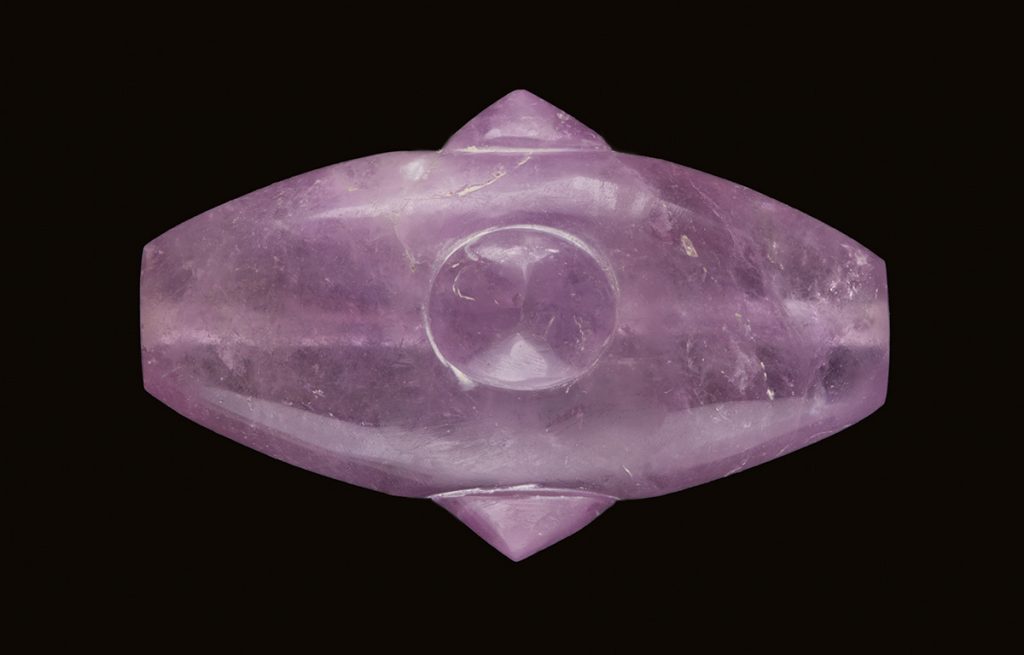Volume 2, Issue 2, March-April 2021
Gemstone Objects from Burma:
gemmological tests and investigation of production technology
by Dr. József Takács
In the past year, we have examined a thousand or so Burmese gemstone objects at the Department of Mineralogy of the Eötvös Loránd University and at the Hungarian Southeast Asian Research Institute.
Our objectives were to:
– Identify the materials used
– Establish the techniques used in their production
– Determine whether they are authentic, ancient pieces
– Identify fakes, copies and objects that have been repaired
– Determine whether the objects have undergone any modification in modern times
– Describe and document the information obtained about the objects (several thousand micrographs were taken in order to document our work)
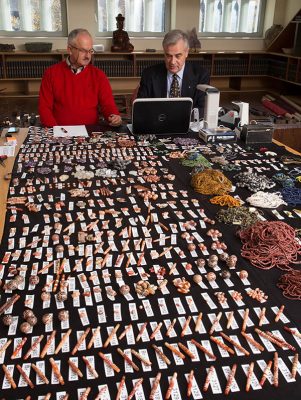
Dr. József Takács and Dr. István Zelnik
Examination methods
We examined the material of individual beads and anthropomorphic and animal shaped figures using conventional gemmological methods, as the individual pieces allowed. In the case of transparent and translucent stones, we primarily analysed optical characteristics and the layout of optical axes, measured refractive indices and studied inclusions.
With non-transparent stones we looked at colours, relative scratch resistance, failure surfaces, cleavage morphologies and relative densities. In each case, documentation was completed with micrographs at 20-40 times magnification.
The Instruments and Equipment Used
We used the following instruments and equipment in our examination and analysis of the gemstone objects: polariscope, refractometer, digital microcamera, laptop, daylight lamp, UV lamp, 10x manual magnifying glass (loupe), scratch test needle, callipers, various testing acids, including hydrochloric acid, etc.
The Materials of the Bread and Figures
The beads, human and animal figures in the Burmese collection largely consist of quartz minerals and gemstones consistent with the local geological environment and originating from mines or natural incidence in Southeast India or Indochina as it is also sometimes known. Varieties of chalcedony such as carnelian, sardonyx, onyx and agate are the most frequent, but there are also examples of silicified wood, rock crystal, smoky quartz, amethyst, chloropal, fluorite, and even rare occurrences of aventurine, serpentine and glass.
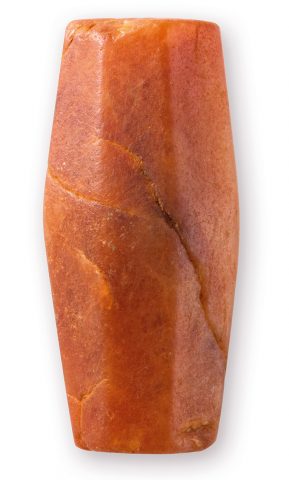
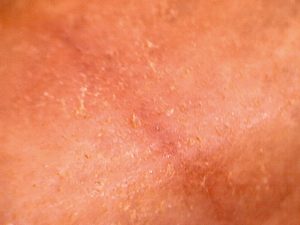

Chalcedony
Chalcedony is a transparent stone that behaves like an aggregate in the polariscope. It has a refractive index of 1.53, is as hard as quartz and its failure surfaces are dull. In appearance it is a cryptocrystalline quartz variety in which very fine fibres of quartz form a dense, fibrous lattice.
Chalcedony doesn’t occur as individual crystals, but in most cases forms surfaces on the inside of spherical or reniform cavities. The quartz fibres are almost perpendicular to the cavity’s surface, resulting in varied patterns depending on the underlying surface. The quartz crystals are not packed perfectly. In between the fibres, chalcedony may containa small amount of water, and it is also able to absorb small particles of various colourful materials. The variation in the colour of those particles results in the variety of colours of chalcedony.
In terms of colour, the Burmese material we examined contained the following chalcedony variants: carnelian (yellow-red, red), sardonyx (red-brown, brown), onyx (black, black and white striped), agate (a banded variety of chalcedony). The frequent banded appearance of chalcedony is primarily due to the different capacities of the layers for absorbing colour impurities. The more a particular layer is able to absorb, the deeper its hue. The grain size of the impurities is usually small and can only be observed with a microscope, while distribution of the grains is homogeneous with in individual layers. Quite distinct from the natural colours, there are also some artificially produced ones that were obtained during the the crafting of the figures through heating, dyeing or bleaching the colours.

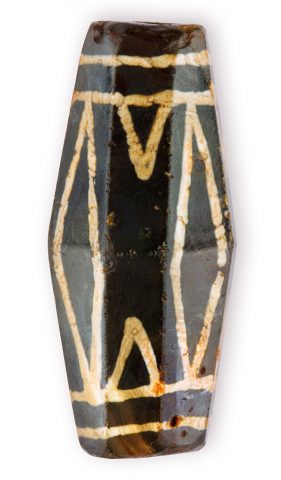
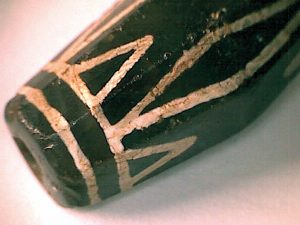

Natural Alterations: Dissolution, Exposure
The primary differences between the strata in agate are in terms of the quantities of colour impurities, but structural differences are also suggested by the fact that the individual bands react quite differently to external factors. This may explain the uneven surface morphologies of some of the objects. Some of the strata have been corroded, presumably due to exposure to chemical agents (dissolution marks), while others have resisted the same effect and were hence exposed, somewhat like the buttes of the Grand Canyon.
Treatments: Heating, Agate Dying, Heating and Dying
Even today, heating is the primary treatment used to improve the colours of carnelian. In the past in India, carnelian stones were laid out to ‘sunbathe’ to deepen their red colour. Observations indicate that the colour of heated carnelians grows deeper not only because the carnelian loses its water content, but also because the red particles that colour the stone amalgamate into larger particles that are observable with a manual magnifying glass. The high colour impurity absorption capacity of the strata of chalcedony has been common knowledge for a long time.
In order to improve low-grade stones, pigment is delivered between the crystals of chalcedony, a process known as agate dyeing. Discolouration along cracks is a way to establish that an agate has been dyed. In the distant past in particular, agates were dyed using natural materials for which the ‘recipes’ were trade secrets.
The fish-shaped figures exhibit many small cracks that form a scale-like texture, which was probably produced by heating and then quickly cooling the material. Those artificial cracks start from the surface inward and are markedly visible against the background.
The appearance indicates dying during the carving of the figures in order to make the objects look like fish scales. The red colour was presumably obtained using a solution containing iron oxide. So in those cases the dyeing was an expressive technique used by creative, highly skilled artists.
It should be noted that with very few exceptions, the objects in the collection are natural in their colours and have been neither heated nor exhibit any trace of dyeing.

Silicified Wood
Silicified wood exhibits the characteristic structure of wood with its oriented, parallel system of vascular tissues. It is as hard as quartz and has dull failure surfaces. The international literature also mentions its use for stringing beads. In these formations, each molecule of the material of the wood has been replaced by silicon dioxide whilst retaining its original structure, the system of vascular tissue in the wood.
The crystalline structure of the silica that fills the structure may vary. They are usually crystallised as quartz chalcedony, but pieces made of opalised palm tree also exist: the so-called pumtek beads. A few of the beads in the material we examined are made of chalcedony silicified wood. In the flat bead, the orientation of the top facet is almost parallel to the vascular tissue.



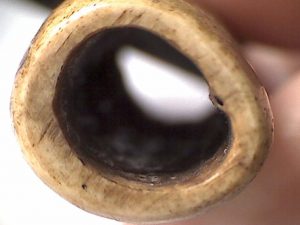
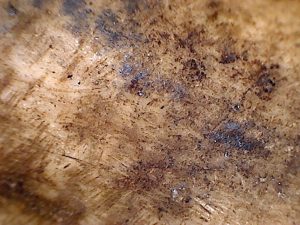
Rock Crystal, Smoky Quartz
Clear, faintly smoke-coloured, transparent and anisotropic, these stones have a refractive refractive index of 1.55 measured using the point method; failure surfaces are shiny with some shell-like shapes. The quartz varieties suited to carving are large, single terminationpyramid crystals. The animal and human figurines often contain biphase inclusions. Their surfaces are often shiny and polished, but there are some specimens that are dull and show some signs of secondary corrosion. In a number of cases, such signs are only visible along deeper carved cuts while the protruding parts are ground and polished. For such examples we may assume that the figure has been reground and polished at a later date. All of these specimens have longitudinal drill holes in them, which, given that the Mohs hardness measure for this mineral is 7, implies superior skill. The holes usually have red deposits, indicating that iron needles were used to drill the stones.
AMETHIST
The amethyst is a pale purple, transparent, anisotropic gemstone with a refractive index of 1.55 measured using the point method; failure surfaces are shiny with some shell-like shapes occurring as large, single termination-pyramid crystals. In places, it has straight, parallel growth bands. In some cases, the surface is shiny and polished, in other instances it is dull, which may indicate secondary corrosion caused by environmental conditions. Figurines with generally shiny surfaces and signs of secondary corrosion in recesses have presumably been reground and polished later. Most of the specimens examined had longitudinal drill holes, often with red deposits inside the holes.
CHLOROPAL
Chloropal is a blotchy, olive-green, opaque mineral which is at best translucent only at the edges. It has a refraction index of 1.44 measured using the point method and a low density with shiny failure surfaces. It contains cracks, in places filled with iron oxides, translucent veins of chalcedony and sulphide mineral crystals. It is somewhat less hard than the quartz variants. It appears as a special material among the pieces in the collection. According to earlier research, chloropal stones contain structurally integrated iron in the form of iron silicate (the mineral nontronite).
FLUORITE
Fluorite is an opaque material at best translucent at its edges with patches of dark green, blue-green and black. It is relatively soft and can be scratched with a steel needle. It has a Mohs hardness index of 4. Its soft ness makes it easy to carve, but it is vulnerable because it splits very easily and split cracks are frequent. Some specimens exhibit lighter discolouration on the surface, which may result in the crack lines becoming clearly visible. In more recent times, these stones are usually reground and polished in a barrel tumbler. This process, aimed at increasing commercial value, firstly highlights the crack lines, and secondly, rotation in the longitudinal direction creates perpendicular grooves in the soft material.
AVENTURINE
Aventurine is a green, tough, hard cryptocrystalline variety of quartz, which derives its colour from the large quantity of small inclusions of green chrome-bearing fuchsite since the translucent-transparent quartz itself is colourless. Its early use in the Far East is a curiosity since, as in Europe, the mineral has only been only known by that name since the 18th century.
SERPENTINE
Serpentine is a dark green mineral with black spots that is soft and easily scratched with a steel needle. The name (derived from ‘serpent’) draws on its spotted appearance. It is a material frequently used for ornamental objects because it is easy to carve and to polish. Old boreholes are always highly irregular in cross section and are funnel-shaped at the ends. The surface is sometimes whitened. It is easily damaged due to its softness. Regrinding and polishing in the modern age leaves easily discernible marks.
GLASS
The glass figurines we have examined are mostly colourful, transparent items. They whitened. It is easily damaged due to its softness. Regrinding and polishing in the modern age leaves easily discernible marks. contain many gas bubbles and crystal germs, tiny crystals. The surface features small, shiny shell-shaped fractures. When the surface is worn away or reground, bubbles may ‘come to the surface’.

MANUFACTURING TECHNOLOGY
1. DRILLED HOLE
All of the figurines and beads have boreholes in them so they can be strung. The holes fall into three categories (small, medium, large); although at the entry points the boreholes grow wider, so there is actually a wide distribution of sizes.
The figurines made of carnelian, sardonyx, agate, fluorite and serpentine usually have small boreholes. The only exceptions are specimens in which the holes have been enlarged using modern tools, but even in most of these examples, the original funnels at the entry point are still visible, particularly in the soft er gemstones such as fluorite and serpentine. Quartz, smoky quartz, amethyst, aventurine, chloropal and glass tend to fall into the medium category, although some of their boreholes have been enlarged in modern times. Onyx is the exception in that almost all objects made of that material have large boreholes that are not wider at the opening.
Boreholes with parallel walls that have been enlarged in modern times oft en exhibit flaking at the edges of the boreholes that has resulted from the use of rigid drill bits. Making a perfect borehole in such hard materials is actually a highly challenging task that requires a steady hand and great technical skill.
The holes were usually made from both sides, using a slightly flattened, pointed, flexible iron needle (arrowhead drill) that was manually rotated in alternating directions with a bow-type tool. In transparent quartz pieces the profi le of the bits is indicated at the ends of the boreholes, while their material is indicated by the red deposits inside the holes. To achieve the desired eff ect, fine grinding material—grains of sand—were inserted by the tip of the bit. With sufficient patience, it is possible to drill holes that are several centimetres long, but the joining of the two holes drilled from opposite directions is in some cases quite inaccurate. Some of the pieces show signs that the holes were later enlarged in modern times using hardened bits, sometimes in several steps.
In such cases, the boreholes have regular circular cross sections and parallel walls, and only the very ends of the holes funnel out somewhat. In the case of the low-diameter original holes, the entrance hole is widened because the manual drill grinds the side as it moves around. The softer the material is, the wider the entry point of the borehole will be. The boreholes on some figurines have straight notches across the entrance; these may have served a number of purposes. Technically, they made it easier to begin drilling as they prevented the bit from slipping, and could also have been used to guide grinding material into the hole.
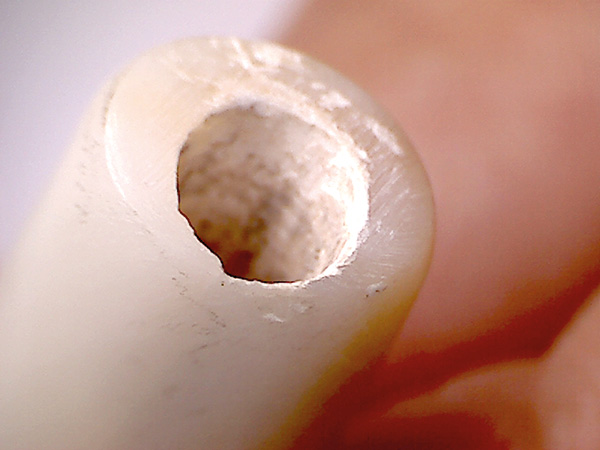
2. CARVING
The animal and human figurines are characterised by archaic forms composed of simple yet expressive lines executed with masterful skill. Straight lines are the norm on all the various pieces, curved lines were clearly much more difficult to produce.
All the pieces bear the marks of primitive tools. The carvings clearly show the marks of early milling heads made using grinding materials of various grain sizes. The shaping cuts on the figures indicate a singlepass working method, in most cases cuts were not polished after they were made.
The marks of the original tools are partly obliterated by recent regrinding and polishing in tumblers and the widening of boreholes presumably performed to increase commercial value. The most modern changes can be seen clearly in the reboring of the holes, which were originally conical, to parallel cylindrical ones with circular cross-sections. The partial fine regrinding of the surfaces is also indicated by waxy [soap?] deposits.
3. TEXTURES
The strange geometric patterns on the carnelian, sardonyx, agate and silicified wood beads, which occasionally include recognisable animal shapes, are a truly special feature of the material. Such patterns are man-made, artistic features since they do not match the natural banding of the agate stones. Although agate dyeing is a process that has been known for a long time, this is something completely different. Techniques have been used that enable them to produce white patterns on the surface of colourful chalcedony stones, presumably by removing the colouring impurities from between the quartz fibres. The technique has been lost, although many attempts have been made to copy its effects. It is certainly clear in some of the patterns that the colour of the originally red carnelian has been whitened along the pattern—as opposed to there being any pigment on the surface—because it is perfectly level with the surface and the polished red parts, as well as exhibiting the original banding.
The red parts were presumably masked in some way to restrict the removal of colouring impurities to the pattern alone. However, there are some cases in which the whitening process has probably also caused structural changes because the white pattern has been raised out of a surface that had originally been ground smooth. The increase in volume suggests that the density of the resulting variant offlint decreased in relation to the chalcedony, which may indicate an opal-type structure. But in those cases as well, the objects have no paint on their surface because both from a side view and where there is chipping it can be observed that the white stripes actually sink into the surrounding original material with a semi-circular cross-section. The collection also features some beads that were coloured using a technique similar to batik. On banded agate, the original surface had been coated with some protective material (masking) the dye then being applied to the pattern alone, where it infiltrated the quartz matrix, as can be seen in picture 1.
A combination of techniques has been used on the silicified wood piece shown in the second photo. The surface of the ground angular bead was first painted and then masked, and the dye was dissolved along the pattern alone, not only from the surface, but also from the silicified wood material. The chipped part around the hole shows that only the surface there had been painted.

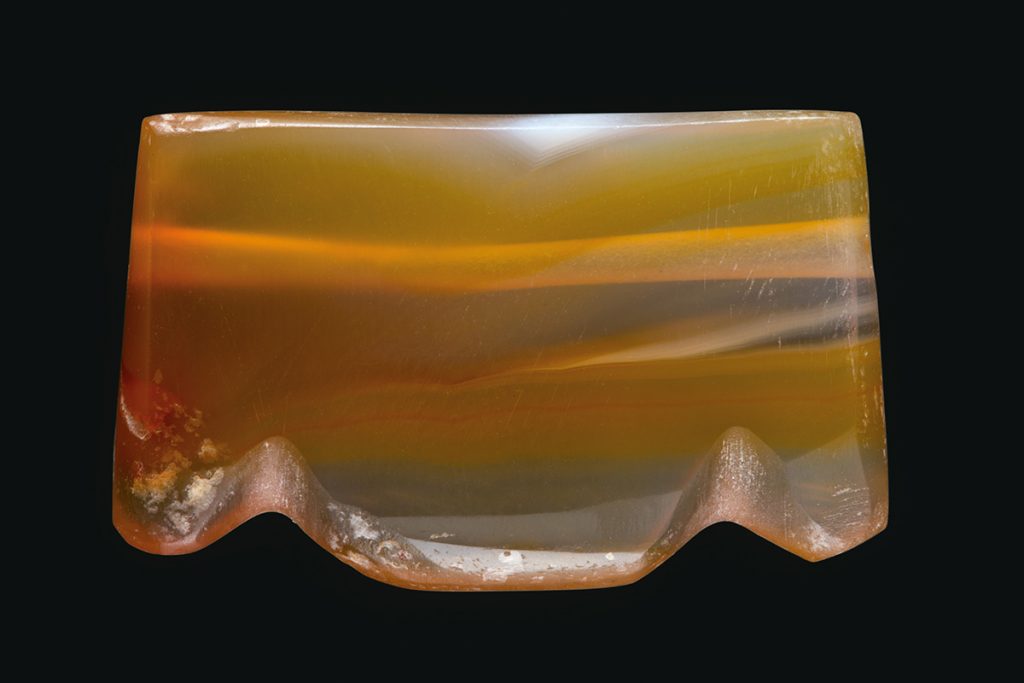
4. FAKES AND COPIES
The enormous demand for talismans, amulets and beads in recent decades has meant a very large quantity of copies and fakes have appeared on the market all around the world. In Burma, Thailand, Hong Kong and Indonesia a cottage industry of small plants exists that manufacture Asian-style beads and talismans from plastic, artificial resin, glass, ceramics and cheap semi-precious stones. Some copies and fakes have also found their way into the Zelnik collection with its very large number of Burmese precious stones: according to the results of over 6000 microscopic examinations, they constitute about 5% of the collection. We present a few typical examples here.
So-called Pyu patterns have been worked and painted onto both old original and raw new carneol and onyx beads. However, due to technical defects in the painting technique the patterns have run, although it is barely visible to the naked eye. The cause was probably that a dye was used that had been diluted too much. The aggressive dye actually has also corroded the carneol.
On the red carneol beads, in the parts with white patterns, black and red lines are visible in the microscopic photos. These carneols are also cracked, probably because they were cooled too quickly following heating during the dying process.
Fake carneol and onyx beads that also feature plastic and metal accessories (ring, cylinder).
Copy of a Pyu gold bead / Br 1866 (microphotos: 5855, 5856, 5857, 5858). The microsopic study clearly shows that it was made using the modern rubber casting method, at top centre there is a ‘running’ line with tiny bubbles, and the etching is also modern, with traces of a modern steel tool.
Fake talisman made of Samon Valley blue glass This piece is made of homogeneous industrial glass ground to a completely shiny and smooth finish using modern grinding equipment, there are no bubbles in the glass (!), the holes are completely regular and made with a modern drill, showing no sign of original, irregular, asymmetrical, funnel-shaped holes.
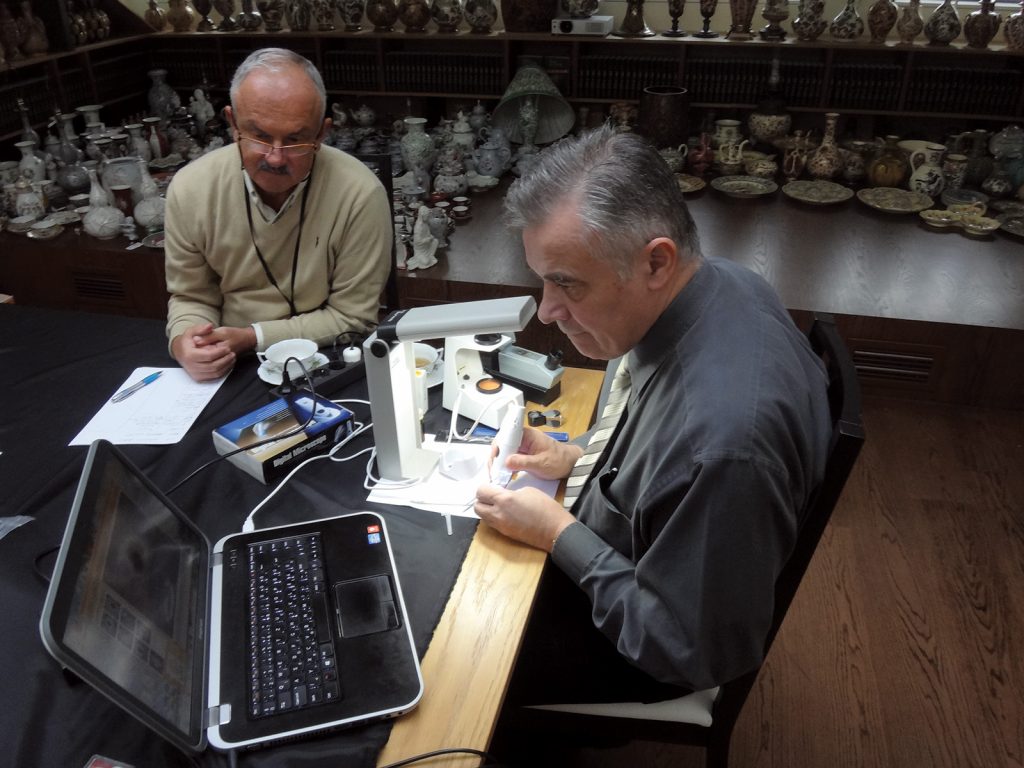
Summary
During our investigation we found that the gemstones used for the various beads and animal and human figurines were all of identifiable materials that had originated from the region.
The pieces we examined bore signs of natural alterations, various types of chemical and mechanical cleaning, machine regrinding and repolishing procedures. That is, the general international practice where objects are cleaned in order to render them wearable again, which makes them suitable for commercial marketing. The extraordinary technical and artistic skills evident in the making of the boreholes and the artistic execution, and the great variety and wealth of motifs in the patterns on the objects, is astonishing. The crafting of the gemstones indicates a deep knowledge of the materials and a superior level of technical skill, including some techniques that are no longer known. Some 5% of the objects, around 50 amulets and beads, were shown to be counterfeits or copies, or had been repaired using adhesives: those were removed from the collection.

